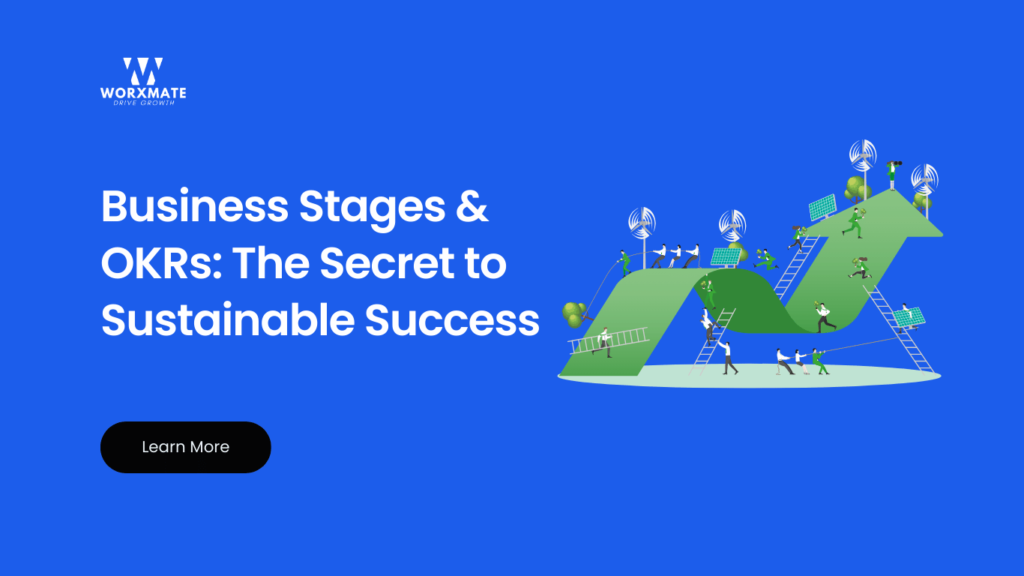The journey from a small startup to a large enterprise is filled with unique challenges and opportunities. At every stage, the ability to maintain focus amidst constant change is crucial for sustained success.
This is where OKRs (Objectives and Key Results) come into play. OKRs provide a robust framework to keep your business on track, aligning your team’s efforts towards common goals and guaranteeing everyone is moving in the same direction.
Whether you’re navigating the unpredictable waters of a startup, scaling up a growing business, or steering a large enterprise, OKRs can be tailored to meet your specific needs and help you achieve your objectives.
The core principles of OKRs remain consistent, but their implementation should be customized to address the unique challenges of each business stage.
Small Startups: Setting the Foundation with Objectives and Key Results (OKRs)
For small startups, agility and focus are paramount. The early days are often filled with excitement, innovation, and a myriad of potential directions.
However, this can also lead to distractions and diluted efforts. Implementing Objectives and Key Results can help startups maintain clarity and prioritize the most impactful goals.
-
Laser-Focused Objectives
Prioritize a few key startup goals that will maximize impact. These goals should be ambitious but achievable, moving the startup to critical milestones.
-
Agility and Adaptability
Startups are still agile. The OKR should be set quarterly, allowing for rapid pivots based on market trends and internal studies. This ensures that the team can adapt to new information and changing circumstances without losing all objectives.
For example, if a key outcome is not achieved due to unexpected complications, the team can immediately rethink the process and adjust the strategy.
This flexibility is important for startups, as market conditions can change rapidly, and the ability to adapt can be the difference between success and failure
-
Team Alignment
Aligning small teams is easy, but it is still important. OKRs ensure that everyone is on the same page and working towards the same goals, creating a sense of purpose and collaboration.
By clearly communicating goals and key outcomes to all team members, initiatives can create a cohesive environment where everyone understands their role and how it contributes to achieving larger goals.
Regular reviews and progress updates keep the team aligned and motivated, ensuring everyone is moving in the same direction.
Growing Businesses: Scaling with OKRs
As industry grows, complexity increases. Multiple teams, multiple projects, and multiple stakeholders can provide Misalignment and loose consensus. Objectives and Key Results help growing businesses stay on track during this expansion phase.
-
Strategic Objectives
Growing businesses need to set growth goals. These may include expanding into new markets, introducing new products, or increasing customer retention.
Key outcomes must be specific, measurable, and tied to these strategic goals. By setting these goals, growing businesses can focus their efforts on the most important areas for expansion and success.
-
Cross-functional compatibility
While there are many groups, it is important to coordinate well. OKRs facilitate cross-functional alignment by ensuring that the goals of all teams are linked and support overall business objectives. Regular check-ins and updates keep everyone accurate and accountable.
For example, marketing team goals should align with sales team goals, ensuring marketing campaigns are driving the right leads that the sales team can convert. This alignment helps avoid silos and confirm all teams are working together towards goals.
-
Performance management
Growing businesses need to take a closer look at how they operate. OKR provides a framework for continuous monitoring and evaluation, helps identify what works and what doesn’t, and makes data-driven decisions to drive improvement
By regularly reviewing progress against key outcomes, companies can identify areas of failure and take corrective action. This continuous improvement makes sure that the business remains focused on achieving its objectives and is adaptable to changing circumstances.
Large Enterprises: Sustaining Success with OKRs
For large enterprises, it is often a challenge to maintain success and drive innovation within complex organizational structures. OKRs can help maintain focus and ensure continuous improvement.
-
A long-term vision
Large companies must balance short-term performance with long-term vision. OKRs help set and break down ambitious long-term goals into manageable, key quarterly results that drive improvement.
For example, a long-term goal may be to become a leader in a particular field. Key outcomes may include developing new technologies, entering new markets, and achieving certain revenue goals.
By breaking down these long-term goals into key quarterly outcomes, large companies can ensure continued progress towards their core objectives.
-
Innovation and efficiency
OKRs encourage a culture of innovation by setting boundary-pushing goals and key outcomes that measure progress towards these new goals. At the same time, they help identify areas of efficiency and improvement.
By setting these innovation-focused OKRs, large companies can ensure they remain competitive and continue to meet the evolving needs of their customers.
-
Employee involvement
Staying involved in large groups can be difficult. OKRs are a transparent and inclusive environment where every employee understands how their work contributes to the company’s goals and encourages a sense of ownership and motivation.
By engaging employees in setting OKRs and communicating progress on a regular basis, great companies can ensure that everyone feels connected to the company’s goals. This participation leads to higher levels of productivity and satisfaction, contributing to overall organizational success.
Conclusion
Regardless of the stage of your business, OKR can be a powerful tool to align your goals with key outcomes and keep your team focused.
By customizing Objectives and Key Results to meet the unique needs of small start-ups, growing businesses, and large enterprises, you can navigate the challenges of any sector with clarity and purpose, keeping your business successful.
By leveraging the power of OKR (Objectives and Key Results), you ensure that your business, no matter how big or small, stays fast, accurate and on track to achieve its goals.
Unlock sustainable growth with the right OKR strategy. Try Worxmate’s OKR tracking software today and drive success at every stage of your journey!



